The liberation of Novorossiysk and the Taman Peninsula. 2 part
Preparation of the operation. The most important component of the entire offensive operation of the North Caucasus Front was the Novorossiysk offensive. In late August 1943, before the command of the 18th Army and the Black Sea fleet set the task of liberating Novorossiysk and developing the offensive in the direction of Verkhnebakansky.
The operation involved the forces of the 89, 176 and 318 rifle divisions, the 83 th naval rifle brigade and the 255 th brigade of the Marine Corps, the 8 th Guards and the 107 th, 81 th Rifle Brigades and 290- of the rifle regiment of the NKVD. Amphibious detachments of the Black Sea Fleet supported them from the sea. Converging attacks on the Novorossiysk grouping of the enemy were inflicted by the Eastern Group of Forces and the Western Group of Forces (from the Myskhako bridgehead). In the port of Novorossiysk, they planned to land a landing party, which was to hit the rear of the German troops, who were beating off the attack of the Western and Eastern groups of the 18 Army.
The eastern land group included the 318th infantry division under the command of Colonel V.A. tanks. Vrutsky’s group received the task, with the support of the landing party landed in the Tsemess (Novorossiysk) bay, to break through the German defense in the vicinity of the Oktyabr cement plant. Then the units of the 318th Infantry Division, in cooperation with their 1339th regiment (he was the third landing detachment), were to liberate the Proletariy cement plant area from the Germans and capture the village of Adamovich Balka. Subsequently, the Eastern Group was to develop an offensive on the outskirts of Methodius and Markotkh Pass.
The western group of troops under the command of Major General N. A. Shvarev struck from the Myskhako bridgehead. The 83-I separate sea and 8-I guards rifle brigades were to capture the western part of the city (height 307.2). The offensive of the Western Group was supported by the landing party No. 1, which included the 255 I naval rifle brigade. The first landing party landed on the southwestern shore of the Novorossiysk Bay. In the future, the Western land group and paratroopers, in collaboration with other groups, were to completely liberate the city.
The Marine Amphibious Group under the command of the commander of the Novorossiysk Naval Base, Rear Admiral G. N. Kholostyakov, included: the 255 Brigade of the Marine Corps, the 393-th Separate Marine Corps Battalion (Second Detachment), the 290-th Regiment of the NKVD and the 1339-th regiment 318 th Infantry Division. Total 6480 fighters and commanders. The artillery of the assault squads included the 41 gun, the 147 mortars and the 53 heavy machine gun. Each paratrooper had anti-personnel and anti-tank grenades. The paratroopers had for each mortar - 30 mines, for a heavy machine gun - 2,5 thousand rounds of ammunition, for a light machine gun - 600, for an anti-tank gun - 80, for each submachine gun - 1 thousand, for each rifle - 300. The group had food for three days. The landing party was divided into three separate units, each had its own task. The first detachment under the command of Colonel A. S. Potapov as part of the 255 th naval rifle brigade was to act in cooperation with the Western group. The paratroopers were given the task of occupying the western shore of the bay in the area from the Refrigerator to the Cape of Love, and then advancing through the city center and seizing the height of 307.2.
Under the command of Lieutenant-Captain V. Botilev, the troop unit No. 2, as part of the 393 separate battalion of the marines and the 290 infantry regiment of the NKVD (the second echelon of the landing force), received the task to disembark in the port and capture the northern coast of the port from the Old Passenger Pier to Forest. Then the paratroopers were to seize the railway station. To advance in the direction of the northwestern outskirts of Methodius, to establish contact with the first detachment. The airborne detachment No. 3 under the command of Lieutenant Colonel S. N. Kadanchik (September 15 will die) as part of the 1339 Infantry Regiment was to capture a bridgehead in the eastern part of the port from the East Pier to the Old-Passenger Pier. Then strike the rear of the German troops, helping the Eastern Group of Forces defeat the enemy forces in the area of the Proletary cement plant, the village of Adamovich Balka and the suburb of Mefodievsky.
For the landing of the forces of the three squads, the Black Sea detachment singled out 148 combat and auxiliary boats, motor and rowing launch boats. They were divided into three groups of amphibious ships. The first and third detachments of the amphibious ships were divided into groups. The first detachment of landing ships under the command of Lieutenant-Commander P. I. Derzhavin had 59 units and was divided into three groups. The second detachment of amphibious assault ships of captain-lieutenant D. A. Glukhov included 18 boats, and the third under the command of captain 3 of rank N.F. Masalkina had in its 26 units of watercrafts divided into two groups.
In addition, they formed a detachment to ensure the landing of the Marine amphibious group under the command of Captain 2 of the rank of VT Protsenko. The support squad included 37 boats, including 32 torpedo boats. The detachment was to ensure the success of the landing operation. It consisted of four groups: breakthroughs, coastal attacks, port attacks, and cover groups of operations from the sea. The breakout group was supposed to destroy the boom-netting barriers at the entrance gates of the Novorossiysk port and torpedoing the moles to expand the aisles for boats with paratroopers in the Eastern and Western moles. The group of the coastal attack received the task of delivering a torpedo strike at the landing site of the first group from the Cape of Love to the West Mall. The port attack group was to break into the port and strike at the landing sites of the second and third airborne units. The covering group received an order to prevent the German ships from breaking into the Novorossiysk Bay and to cover the landing operation from the sea. At the same time formed a detachment of fire assistance, it included three destroyers. The fire assistance squadron was given the task of striking the enemy’s artillery positions in the area of Yuzhnaya Ozereyka, Glebovka, Vasilyevka and Borisovka when the operation began. Three armored boats and four torpedo boats covered the entrance to the Novorossiysk Bay. Several minesweepers organized an ambulance to transport the wounded.
To mask the beginning of the landing operation, the detachment of ships from Gelendzhik into the sea, and their construction was carried out at night, the transition to the landing sites was planned after the moonset. Airplanes had to patrol over the bay in order to drown out the work of the engines of ships with their noise. The transfer and landing was supposed to be carried out in two echelons. In the first echelon there were the 255-I brigade of marines, the 393-th separate battalion of marines and the 1339-th infantry regiment. They landed on landing craft in Gelendzhik Bay. In the second echelon, the 290 th regiment of the NKVD and part of the 255 th brigade of the marines marched, they were put on ships at the pier on the 9 kilometer of the Novorossiysk highway and at Kabardinka. The landing should have been completed by the 21 hour, since the 5 hours were assigned to the landing transfer. The landing of both echelons was planned to be completed before the dawn of the first night. Simultaneously with the commencement of the artillery preparation, the breakthrough group advanced forward, striking at the bosnet barriers and torpedoes, widening the pier holes. The breakout group boats were supposed to land assault groups that put signal lights on the ends of the pier, meaning that the “way is free”. After being hit by a group of shore attacks. At this time, the ships of the amphibious detachments entered the bay and went at full speed to the landing sites. Simultaneously with the landing of the airborne detachments, the Eastern and Western groups of forces began an offensive.
148 airplanes supported the operation from the air: the 88 aircraft were allocated by the Black Sea Fleet, 60 - by the 4 airborne army. The 18 Army for breaking through the German defense and assault support, in addition to the existing combined artillery, received 8 reinforcement artillery regiments, one 203-mm cannon artillery brigade, one mortar regiment, 6 Guards mortar regiments, one heavy guards brigade, one-time art patterns, one-piece guards, one-time guards, one heavy guards brigade, one-time art patterns, one guards, one mortar regiment, one heavy guards, one single guards brigade, one-time art, one-piece guards, one mortar regiment, one heavy guards brigade, one guards, one mortar, one guards, one regimental command, one guards, one mortar regiment, one guards, one mortar, one single guards brigade, one art. fleet. In total at the disposal of the command of the army were about 47 guns and mortars. At the same time, 800 guards mortar installations were concentrated on the breakthrough site. For better control, all the artillery was brought into one army art group. The amphibious assault force was supported by 227 guns, which were divided between three subgroups. Each artillery subgroup supported one of the airborne units. During the crescent before the start of the operation, an 208 artillery group of 50-mm and 52-mm artillery units methodically attacked enemy defenses. The total 203 Army's artillery preparation was supposed to start 18 minutes before the landing of the airborne groups, then the artillery fire was transferred deep into enemy positions. Adjustment of the fire should have made special posts that landed with amphibious groups. They were equipped with radio stations.
Soviet troops conducted a great preparatory work. The operation required exceptionally clear control, interaction at sea, land and air. All ships and vessels were adapted for amphibious actions. Intensive work was carried out by scouts, establishing the number of enemy troops, the system of its fortifications and fire. Particular attention was paid to the breakthrough areas of the Eastern and Western groups and the landing of assault forces. In the area of Gelendzhik built fortifications, imitating the German defense. A week and a half of paratroopers were preparing to break through the defenses of the enemy. Every night, the landing party worked out the elements of embarkation and disembarkation. The crews of torpedo boats practiced the destruction of the boom barriers. Much attention was paid to the engineering training of airborne units. All detachments were divided into lashing and securing units, as well as assault groups. All rifle formations worked out the elements of the demining business, primarily in the detection and clearance of mines, in overcoming obstacles. All assault groups were provided with special equipment: "cats", assault bridges, easy bridges to overcome the minefields. Much attention was paid to the moral training of fighters. Lectures, group and individual conversations, meetings were held, patriotic films were shown to the soldiers. The political and commanding staff of the army did a great job of strengthening discipline and organization, increasing the morale of the fighters.
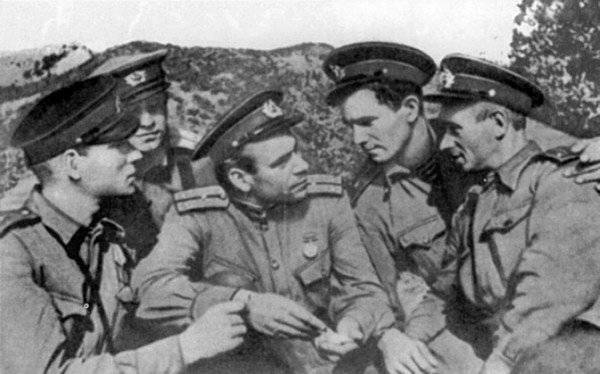
The commander of a company of machine gunners of the 393-th separate battalion of marines AVRaykunov before the landing in the port of Novorossiysk. September 1943 of the year.
The Soviet command tried to preserve the strict secrecy of the operation and misinform the enemy. All regroupings, trainings tried to be carried out in the dark. The region of Gelendzhik was securely covered from the air. The German command was told that the Soviet troops were preparing a landing operation in the area of South Ozereyka. They even issued a special directive (false) on conducting an operation in the South Ozereyka area. In this area, intensified reconnaissance activities, planted scouts. I must say that this was one of the most well-prepared operations of the war.
Assault
On the night of September 10, the operation began. By 21 o’clock, the first and second landing troops boarded the ships and went to sea. The third detachment was delayed landing for an hour and was forced to catch up with other detachments. The landing detachments were late for 45 minutes, so the headquarters postponed the beginning of the landing from 2 hours 15 minutes to 3 hours 10 minutes. At 2 hours 44 minutes, all units took up their original positions. Aviation and artillery began to inflict massive attacks on enemy positions. 800 guns and mortars brought down the wall of fire at the enemy’s position. Over the Novorossiysk Bay carried fiery volleys of Katyushas. The Germans were taken by surprise. They did not expect this blow. The city started fires. The smoke from them helped to disguise the landing. True, the smoke interfered with the orientation of the paratroopers. The Germans came to their senses from the first shock and returned fire from 40 artillery batteries and six-barreled mortars.
Breakthrough group boats made their way to the breakwaters, destroying the boom and minefields at the port’s entrance gates. They were followed by a group of coastal attacks, striking the enemy’s firing points on the coast and the moorings. There were explosions of immense power. Soviet torpedo boats destroyed around the 30 enemy pillboxes and bunkers near the coastline. Then they quickly landed assault groups on the Western and Eastern moles, which gave signals that the path was clear. Everything was happening fast. Already in 2 hours of 56 minutes, boats of the port attack group broke into the port and began striking enemy firing points on the berths and on the shore at the landing sites of the landing groups. At this time, the German gunners rained down at the entrance gate to the harbor. Their width did not exceed 80 meters. The paratroopers of the second detachment, the 393-th separate battalion of marines, broke through the gates first. In 20 minutes, landing ships and ships landed about 800 fighters. The battalion was armed with 10 mortars, 19 heavy machine guns and 40 PTR. The landing took place at the Elevator and Petroleum loading docks. Marines on the move captured several marinas in the north-western part of the port.
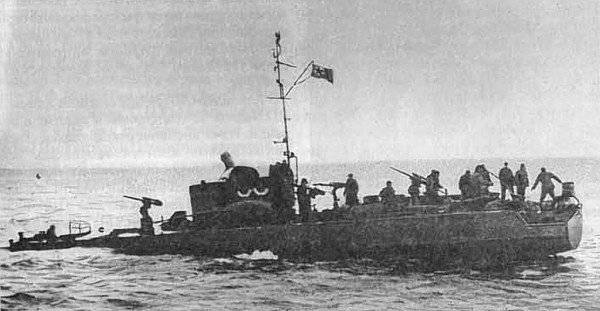
The damaged SKA №0141 returns under its own power to the base after the Novorossiysk landing operation. 9-10 September 1943 of the year.
After the second detachment, the fighters of the first and third detachments began their landing. In 30 minutes, more than 1 thousands of people from the 1339 regiment (the third detachment) landed at the wharf at the pier and at the power station. They were able to unload several 45-mm guns, 20 mortars and 10 heavy machine guns. The first airborne unit (the first echelon of the 255 brigade) encountered serious difficulties. The marines ran into a powerful artillery-mortar fire. In addition, the shallow depth at the landing site - at the Coastal Pier and on the coast from Cape of Love to the root of the West Pier, prevented the courts from coming closer. People had to plant on boats, motoboats and motobarkasy. Landing was delayed until 4 hours 25 minutes. The Germans sank part of the craft. Many ships that returned to Gelendzhik were seriously damaged and in need of repair. The first squad landed separately, suffered heavy losses. Having spent all the ammunition, the soldiers of the 255 maritime brigade on the night of September 11 broke through to the troops of the Western Group who were trying to break through the enemy defenses in the Stanichka area. As a result, the Soviet paratroopers managed to create two small and disconnected springboards.
At the same time, the Eastern and Western groups of troops began an offensive with the paratroopers. They attacked from the cement plant "October" and from the bridgehead Myskhako. The Germans have been preparing defenses in these areas for many months, waiting for attacks here. Therefore, although fierce battles were fought here throughout September 10, the Soviet troops failed to break through the German defenses. Recovering from the first strike, the Germans began to put up fierce resistance. Used tanks.
2-th landing squad stubbornly moved forward, showing the wonders of courage and self-sacrifice. The 393 th separate marine battalion was formed from the fighters of the legendary detachment Major Ts. L. Kunikov, who landed in February 1943 of the year in the area of Stanichka. Many marines were members of previous violent battles for Novorossiysk. These were the fighters whom the Germans called the “black death” with fear and respect. They fought for their hometown, for the largest base of the Black Sea Fleet, to defend which was an honor for them. Showing great skill, determination, and at the same time neglecting death, the marines beat the enemy without sparing their strength, blood, and life itself. Soon the sailors made their way to the embankment and took the Sailors' House and the club by storm. At dawn, the Marines captured the station. The squad leader Smorzhevsky hoisted the Soviet Naval flag on it.
The marines fought without sparing their lives. In the battle for the power station, the foreman of 1-th article Ivan Prokhorov left for the sky team. A platoon under enemy hurricane fire went on the attack. Prokhorov destroyed an enemy machine-gun calculation with a grenade, killed three enemies in a melee. Meter by meter, the heroes moved forward, making their way with grenades and bayonets. During one of the attacks, a mined wire fence blocked the road. Every second of delay threatened with death. Then Ivan Prokhorov stepped forward and said: “I, probably, will die, guys. Consider me a communist. ” He rushed forward. The first mine exploded. The Marine fell. But then he got up and, staggering, leaning on the machine gun, moved on. Second blast. The hero died. But a passage formed in the barrier. The fighters rushed forward.
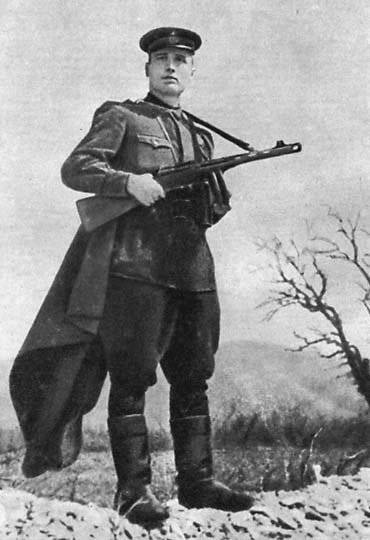
Lieutenant-Captain V. Botilev, Commander of the 393-th Separate Marine Battalion (BMP). "The brightest personality of the Novorossiysk landing force" according to the characteristics of the commander of the landing operation, Vice-Admiral G. N. Kholostyakov.
In the area of the power station, the soldiers of the 1339 Infantry Regiment heroically fought. The enemy turned the power station building into a powerful stronghold. Almost a third of the city could be seen and fired from the area of the power station. The first to penetrate the power station was the company of captain M. N. Kirichenko. Private Firsov with a red banner made his way upstairs, but died the death of the brave. The banner was picked up by the sergeant Alekseev, the Komsomol of the battalion. The Germans pulled reserves and surrounded the troops. 1339 th regiment fought surrounded. The German command, realizing the danger of the enemy’s forces in the rear of his defense and in the center of the city, threw virtually all of his reserves against the paratroopers. Every hour it became harder and harder. By the end of the day, the Germans, pulling up reserves, pressed the airborne units to the sea. The German reserves consisted of various units of the 101 th light infantry, 9 th, 73 th and 125 th infantry divisions.
Taking advantage of the fact that the main attention of the German command was riveted on bridgeheads that were occupied by paratroopers, parts of the 318 th rifle division were able to achieve some success in the area of the enemy's stronghold on Sugar Loaf Mountain. Commander Leselidze, seeing that a critical moment was coming up in the battle, decided to transfer the 1339 regiment to the rescue — the 1337 th regiment of Lieutenant Colonel G. D. Bulbulian. On the night of September 11, the landing force set sail. In its composition was the division commander Vrutsky. By this time, the Germans completely blocked the 1339 th regiment, repulsed moles and moorings, hastily strengthened them. As a result, the 1337 th regiment had to solve a difficult task - to land on a heavily fortified shore and unlock those surrounded. Soviet arrows made their way through the enemy’s heavy fire, landed on the coast and launched an offensive. The regiment beat the Germans home after home. Soon, the arrows connected with the Marines of the second airborne detachment in the area of the port workers' club. The German command threw into the battle more and more new reserves, trying to stabilize the situation.
The command of the North Caucasus Front, realizing that the 318 Division’s forces were not enough to break through the enemy’s defenses, transferred the 55 Guards Irkutsk Division from the reserve under the command of Major General B. N. Arshintsev and the 5 Guards Tank Brigade of Colonel P.K. Shurenkov. At the same time, the actions of artillery and aviation were corrected. All the power of artillery was concentrated on the German resistance centers in the area of the cement plant and the Sugar Loaf Mountain. The extermination cover of the advancing orders of the 18 Army was strengthened. Increased the power of bombing attacks. In order to deprive the German command of the ability to maneuver the reserves, the 9-I army was ordered to go on the offensive in the morning of September 11. The transfer of reinforcements to the landing force, which was threatened with destruction, and the strengthening of the Eastern grouping of the 18 Army, the concentration of efforts of artillery and aircraft, the introduction of tanks into battle, were crucial in the battle for Novorossiysk.
However, in order to enter into the battle tank connections, it was necessary to solve a very difficult task. We had to overcome Kamyshovskuyu beam depth of more than 6 meters. The bridge over it was destroyed. Attempts to restore it were unsuccessful because of the powerful fire that the Germans were from the mountain Sugar Loaf. The task was solved by the soldiers of the 383 engineering battalion. Under enemy fire, they built a stone lintel, manually carrying the stones. Tanks were able to join the battle. The 318 division in a night battle broke down the resistance of the enemy and in the morning of September 11 united with the units of the 1339 Infantry Regiment. By lunchtime, Soviet troops seized the area of the Krasny Oktyabr cement plant, the village of Turkish Garden, a power station, and the Proletary cement plant.
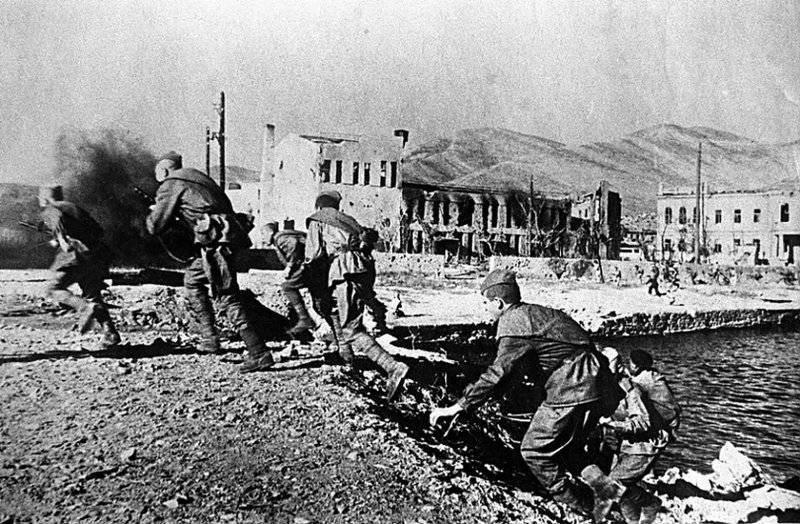
During 12 — 13 September, the Soviet command brought into the battle second echelons of assault forces. The 393 th separate marine battalion and part of the 290 Infantry Regiment of the NKVD fought hard in the area of the station and the elevator. The Germans, with the support of tanks, went on counterattacks, fought hard and skillfully. On the morning of September 13, the 55-I Guards Rifle Division entered the battle. The Germans tried to concentrate forces in the Sugar Loaf Mountain (up to two infantry regiments, 20 tanks, assault guns division) and close the gap, cut off and destroy the advanced parts of the 318-th rifle and 55-th Guards Division with a strike in the direction of the October-October cement plant. The Soviet command unraveled the enemy's plan. The main forces of the 318 Division turned to the north-west direction, towards the passes of Markoth and Neberjayevsky, in order to reach the rear of the Germans. This decision prevented the enemy from flank attack on the Eastern group.
At the same time, the Soviet command for the development of success concentrated in the area of the cement plant "October" a powerful shock fist. It includes units of the 5 Guards Tank Brigade, one regiment of SAU, one anti-tank artillery regiment, one engineering battalion. They were supposed to develop the success of the 318 Infantry Division of the 55 Guards Division. At the same time, units of the 414 Infantry Division commanded by Major General GG Kurashvili were transferred from the reserve of the front to the battle area.
Enemy resistance is weak. The Germans suffered heavy losses: two port teams were almost completely destroyed, the 186 regiment of the 73 infantry division was reduced to a battalion because of the losses, the 228 regiment of the 101 light infantry division lost more than 40% of its composition, etc. Germans tactical reserves were spent. There were almost no operational reserves. Reinforcements from other sectors of the front could not be transferred; the 9 and 56 of the Soviet armies launched an offensive.
56 September 14 Army struck at Kiev and Moldavan and Nizhne-Bakansky. Novorossiysk group Wehrmacht threatened environment. Part of the 18-th army went to Markot Pass. The shock grouping of the 18 Army, jointly part of the 55 Guards Division, broke the enemy’s defenses around the station and began moving in the direction of Tsemdolin. September 15 continued hard fighting. The Germans fiercely resisted, went into counterattacks. Soviet troops continued the offensive. Fighters of the 55 Guards Division reached the area of the elevator, station, oil tanks, pier number 5, united with the marines of the separate battalion of the 393. On the same day, the Western Group of Forces began to squeeze the Germans, it advanced 1,5-2 km.
German defense was broken. The 4-I Mountain Division was under the threat of encirclement. By the evening of September 15, the Germans began to withdraw troops. Intelligence has established that the Germans are moving away in small groups in the western and north-western directions, hiding behind mortar and artillery fire. At 9 hours of the evening the German command began the withdrawal of the main forces.
At night, the Soviet troops destroyed up to two battalions of the Romanian 4 th Mountain Division, clearing the southern part of the city. In the center of the 55-th Guards, 318-th and 414-rifle divisions to the 10 September 16 watch completely cleared the German port and the northern part of Novorossiysk. Developing the offensive, by the end of the day, Soviet troops fought for the Neberdzhai, Kirillovka, and Tsemdolin pass. The advanced units of the 176 Infantry Division and the 81 Infantry Brigade of the Western Group reached the line Borisovka, Vasilyevka and Glebovka.
September 16 in Moscow 20 hours saluted twelve artillery volleys from 124 guns in honor of the valiant troops liberated Novorossiysk. The ships of the Black Sea Fleet also made a salute with twelve volleys in honor of the release of the second base of the Black Sea Navy.
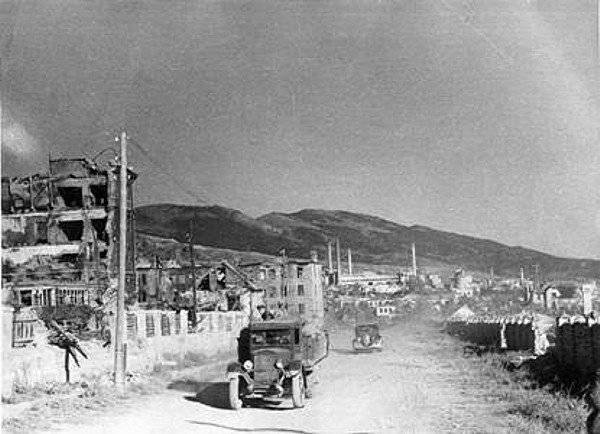
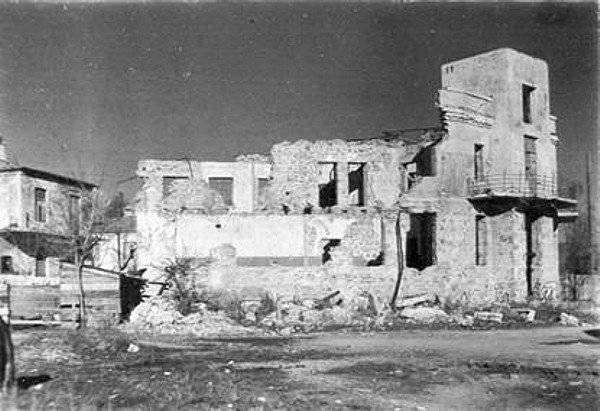
The ruins of the liberated Novorossiysk. September 1943 of the year.
To be continued ...
- Alexander Samsonov
- The liberation of Novorossiysk and the Taman Peninsula. To the 70 anniversary of the Novorossiysk-Taman offensive operation
The liberation of Novorossiysk and the Taman Peninsula. 2 part
The liberation of Novorossiysk and the Taman Peninsula. 3 part
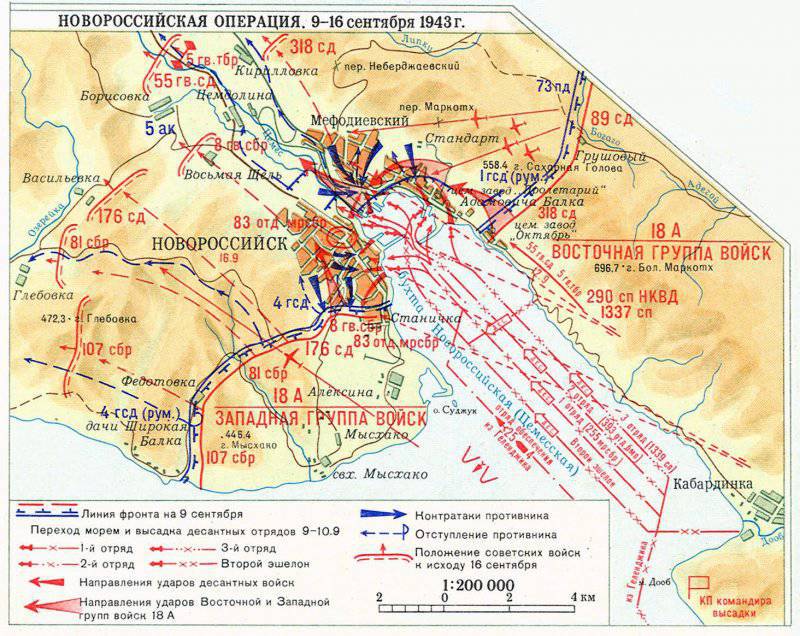
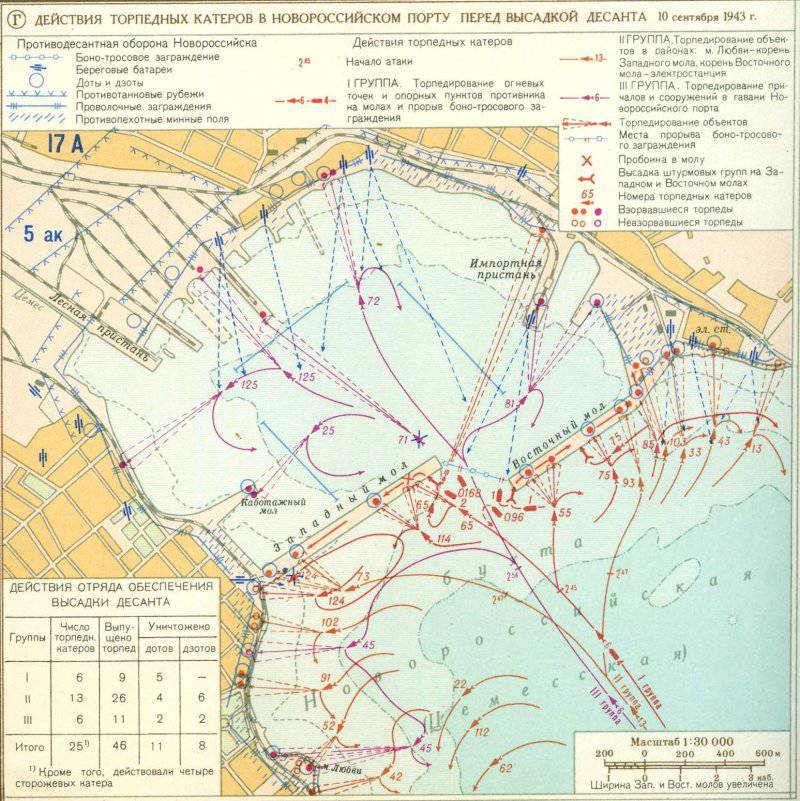
Information